Jesuit community examines the impact of evangelization and colonization on Native Americans
DETROIT ─ The St. Jean de Brebeuf relic tour stopped at University of Detroit Jesuit High School and Academy on March 3, allowing people to venerate the skull of the famed North American martyr up close.
The skull of St. Jean de Brebeuf, along with relics of St. Gabriel la Lamont and St. Charles Garnier, was on display at the Chapel of the North American Martyrs at the U of D high school campus for public veneration and a conference to learn more about the legacy of the North American Martyrs, a group of eight men killed while evangelizing to American Indians in modern-day Ontario and upstate New York in the 17th century.
The tour, sponsored by the Vocation Offices of the United States and Canada Conference of the Society of Jesus, began Feb. 9 in Centennial, Colo. and will travel throughout the country, culminating in a stop at St. Patrick’s Cathedral in New York City on March 6.
The purpose of the tour is to promote vocations for the Society of Jesus, explained Fr. Eric Immell, SJ, custodian of the relic and vocations promoter for the Jesuits’ Midwest Province, and to learn more about St. Jean de Brebeuf and the legacy he and his companions had in evangelizing North America.
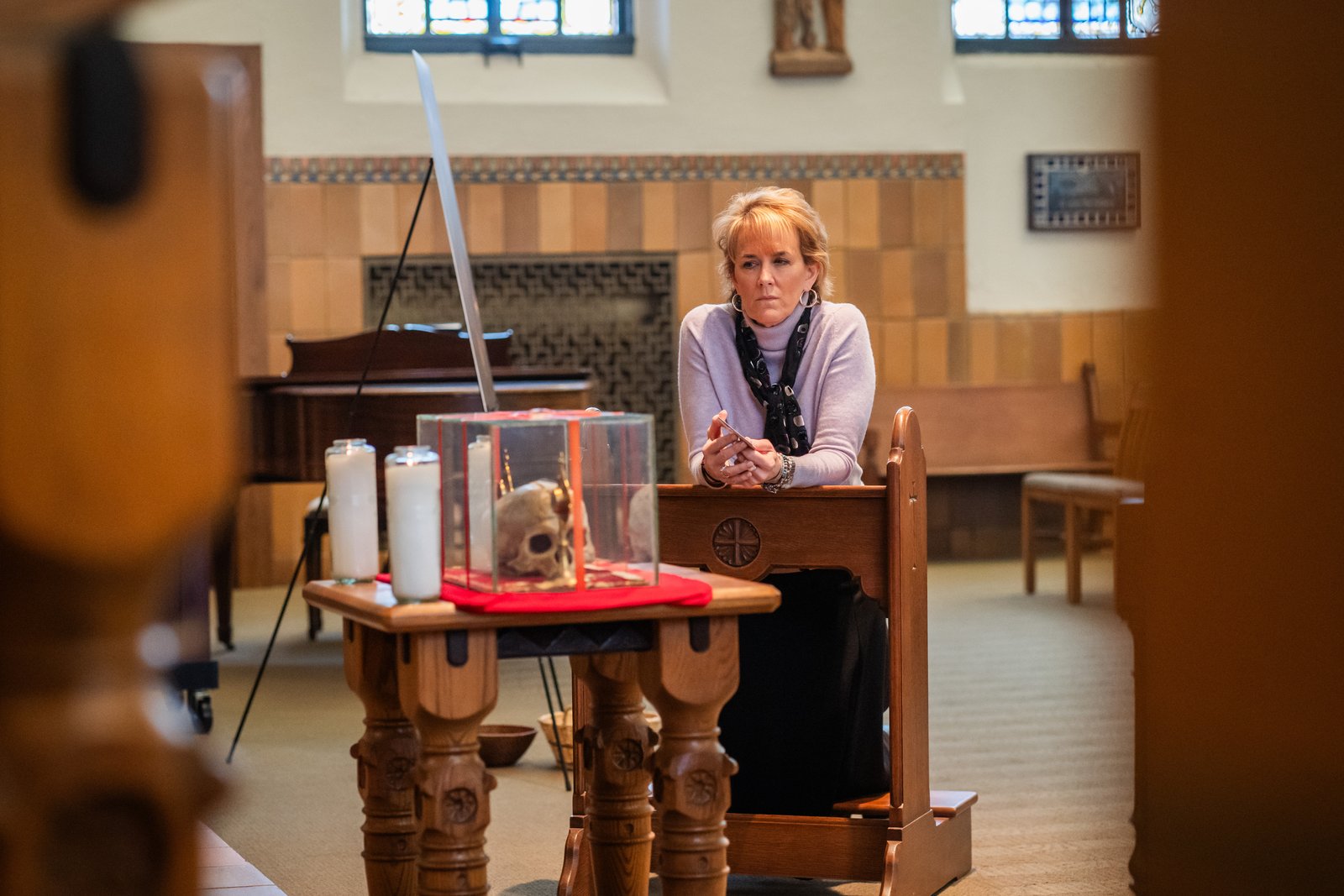
“Fr. Jean de Brebeuf spent a total 19 years of his life among the Huron Indians,” Fr. Immell told Detroit Catholic. “He learned the language, composed a dictionary for them, composed what is said to be the oldest Christmas carol in Canada in the Huron language, called the 'Huron Carol'. He translated catechetical documents into the Huron language so they could learn the faith and the culture. He made it possible to relate the Catholic faith in ways that were already integrated into their life, which was a unique missionary approach, as opposed to inviting people to change every aspect of their life.”
Fr. Jean de Brebeuf was born in Normandy, France, in 1593 and was 23 years old when he entered the Society of Jesus. After professing vows of poverty, chastity and obedience, he was sent to New France (modern-day Canada and Upstate New York) where he ministered to the Huron-Wyandot people.
Fr. Brebeuf left North America after the English took over the area where he and his companions were ministering. But he returned four years later after he experienced a “second conversion" to recommit to evangelization.
He continued to minister to the Huron, until 1643, when the Iroquois attacked the village in which Fr. Brebeuf and his companions were ministering. Fr. Brebeuf was tortured and martyred in a gruesome manner that involved his captors pouring boiling water over his head – in a mockery of baptism – all the while, Fr. Brebeuf was forgiving his captors and praying for their conversion.
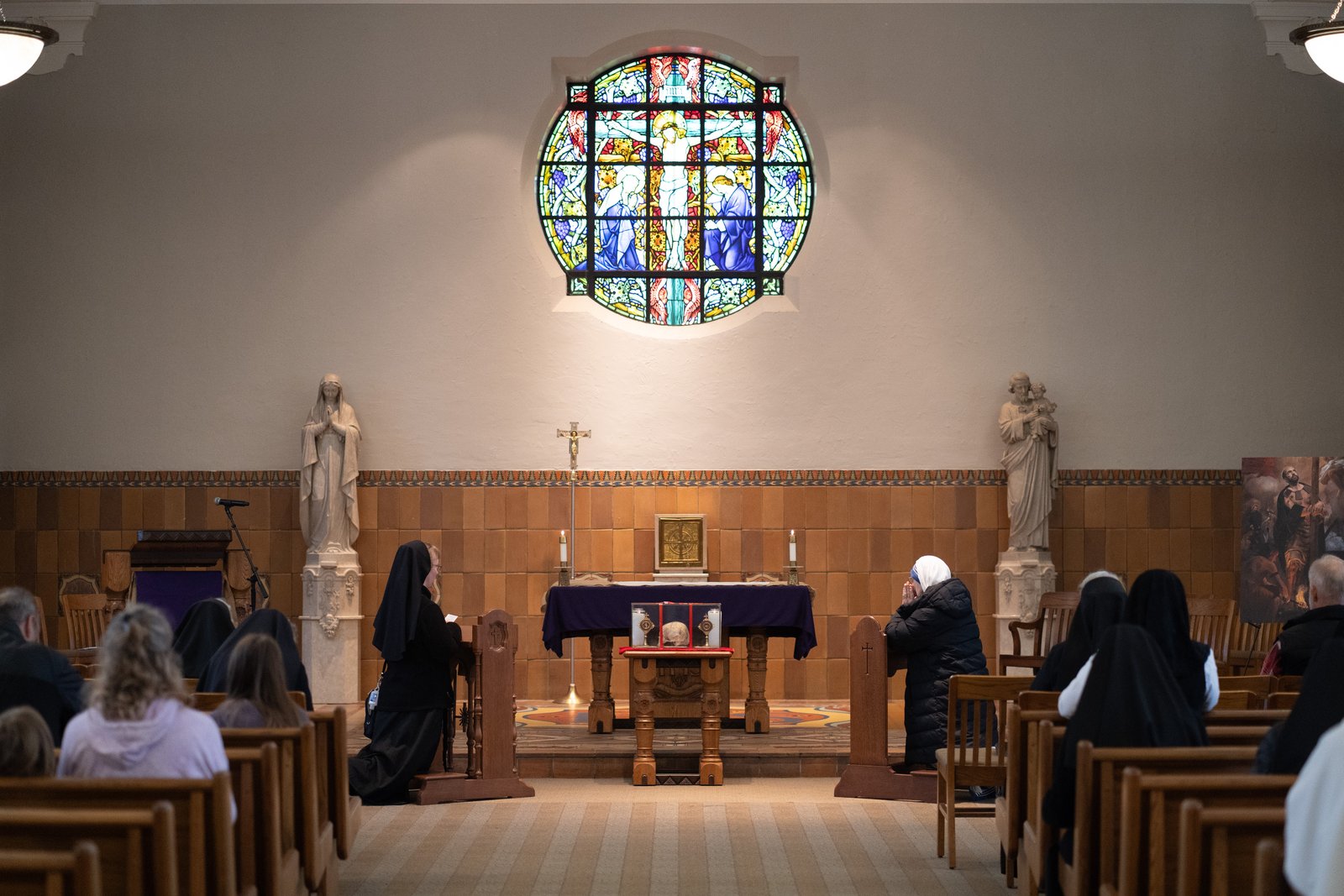
Fr. Immel hoped the visitors who came to the chapel to view the relics would draw strength from St. Jen de Brebeuf’s courage and missionary zeal.
“The tour is meant to, number one, invite people to see these beautiful relicts, to witness his discipleship, his missionary work and his martyrdom,” Fr. Immel said. “But number two, our deep hope is that young men, who might have the sense religious life is a possibility for them, to view these relics and inspire them more deeply to pray about whether or not they want to become members of the Society of Jesus.”
The public had two hours to venerate the relic up close, placing rosaries, holy cards and other personal items on the glass container of the relics of Ss. Jean de Brebeuf, Gabriel la Lamont and Charles Garnier, and to pray in the chapel, which is adorned with stained glass windows depicting the ministry and martyrdom of the North American Martyrs.
Public veneration was followed by two presentations: Fr. Jim Kennedy, SJ, of the Martyrs Shrine in Midland, Ontario, spoke about the life and ministry of St. Jean de Brebeuf, and Bro. Jim Boynton, SJ, president of University of Detroit Jesuit High School, discussed the legacy of colonization and evangelization for the American Indian community.
Fr. Kennedy spoke on how the biography of St. Jean de Brebeuf and his companions captures what he and the other Jesuits did in North America, but to get a complete picture of his ministry – and legacy – one has to look at the broader context of what was happening in Europe and the Catholic Church, particularly, the need to preach the Gospel to the ends of the Earth.
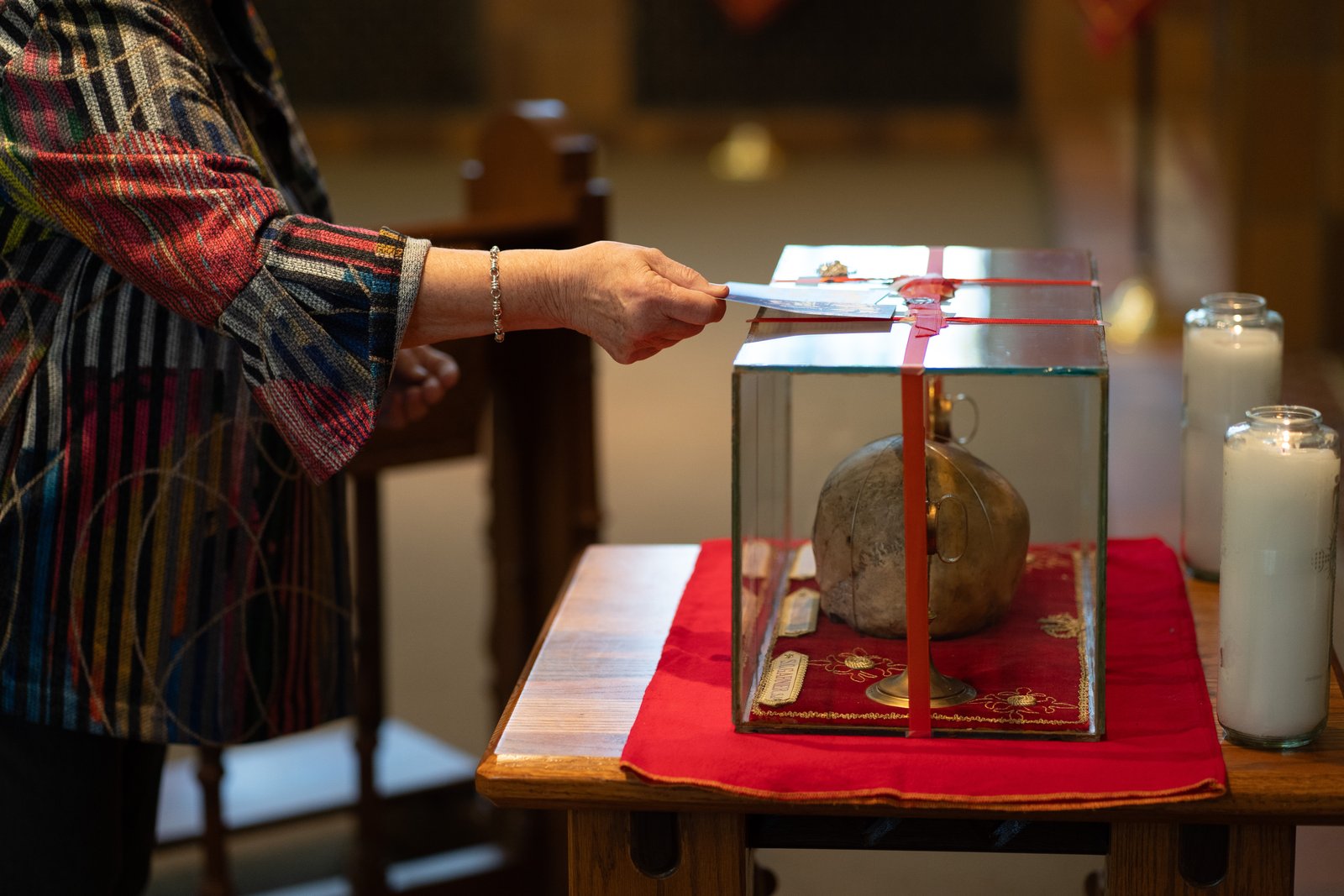
“Much of Brebeuf’s life was amidst anarchy, from the Wars of Religion in France to the 30 Years War in the wake of a Protestant Reformation, which was just as much a social-political phenomena as it was a religious one,” Fr. Kennedy said. “Fr. Brebeuf lived 100 years after Ignatius of Loyola, was educated at the Jesuit college and brought up in a response to the Protestant reformation that the mission of the church was to spread the Gospel all over the world.”
It is in this context people can better understand who the North American Martyrs were and their goals: not to spread “civilization” or French nationalism – the concept of a French nation-state really didn’t exist in the early 17th century, Fr. Kennedy explained – but to spread the Gospel.
Regarding what the Huron people thought of St. Jean de Brebeuf, Fr. Kennedy looked to what the Huron-Wyandot people called Fr. Brebeuf – "Echon," or “The Healing Tree.”
“A key frame of reference is the name St. Jean de Brebeuf was given by the Huron people, ‘Echon,’” Fr. Kennedy said. “Some debate the meaning of the name, but I for one favor, ‘The Healing Tree.’ In the Huron-Wyandot nation, this signified someone was a leader, one who was strong in the poverty of others. I can’t help but imagine how much Jean would have liked that name. A man who was a companion of Jesus, whose own healing tree was the cross we will venerate on Good Friday.”
Bro. Boynton, himself a card-carrying member of the Sault Ste. Marie Tribe of the Chippewa Indians, began his presentation by noting how U of D High’s chapel is probably the first Catholic chapel dedicated to the North American Martyrs. The chapel’s construction was completed in 1930, the year the eight North American Martyrs were canonized.
Bro. Boynton then lit smudge, an Indian incense used for purification before the start of prayers and ceremonies, similar to the use of incense during Mass.
The respect and incorporation of Indian rituals and practices, edifying them through Christian adoption, was a tactic the first Jesuit missionaries used to bring Christ to the American Indian nations, Bro. Boyton said.
“This is how evangelization to Native Americans began 500 years ago, there was a smudging, a cleaning and a blessing,” Bro. Boynton said. “Fr. Jean de Brebeuf would have smudged, Fr. Jacques Marquette, a hero of mine, who is buried in my hometown, would have smudged. When Pope John Paul II and Pope Francis both visited Indian communities, they smudged. When the first missionaries came to this country, they embraced what they could about Native American culture.”
Bro. Boynton, whose expertise is in the second wave of Jesuit missionaries who came to North America, said the principles of cultural understanding and adaptation were lost along the way as the Church – and the rest of Western Civilization – continued to expand across the continent.
“Marquette pulled up with his vow cross in one hand, to show he came in the name of Jesus, but in the other hand, he carried a pipe; Fr. Marquette was honored by the Ojibwe Tribe as a pipe carrier, to show he came in peace and was a mediator,” Bro. Boynton explained. “When Fr. Marquette came into the village, he came with Jesus, and he came in peace. You could not get more inculturation than that.
“Early on in the evangelization by the Jesuits, you see tremendous inculturation,” Bro. Boynton said. “What we are going to see, sadly, is later on the church progressed as Western Civilization progressed, and in the case of Native Americans and Indigenous people, cultural integration became less and less.”
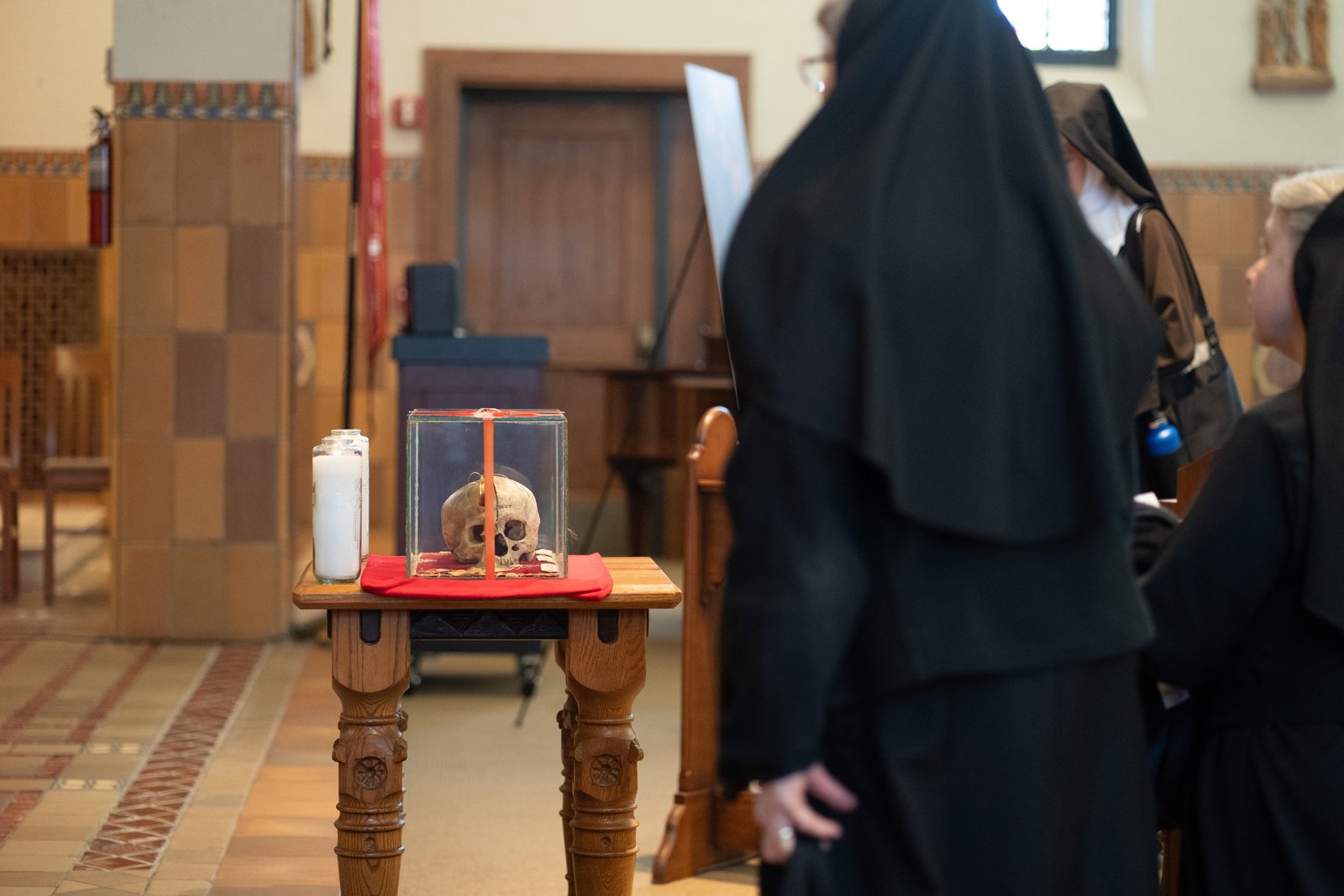
Bro. Boynton described how state-church cooperation led to a culture of assimilation over inculturation. The United States and Canadian governments would commission Christian denominations – including the Catholic Church – to run government-funded boarding schools where American Indian children were forcibly removed from their families to “kill the Indian, save the man.”
Bro. Boynton’s grandfather and grandmother both attended Indian boarding schools, and his conversations with them and others show there are mixed experiences for each person.
Whenever his students ask Bro. Boynton about how he reconciles with the past as both a professed Jesuit and an American Indian, he says he finds no contradiction between his heritage as an Indian and the saving message of Jesus Christ and His Church.
“I’ll start with this: Adam and Eve at the apple, there is sin in the world, bad things happen,” Bro. Boynton said. “That’s why we have redemption through Jesus Christ. When you look at the history of evangelization and colonization with Native Americans on our continent, the sin was pretty evident. It’s a message that is oftentimes difficult, but one always worth examining.”
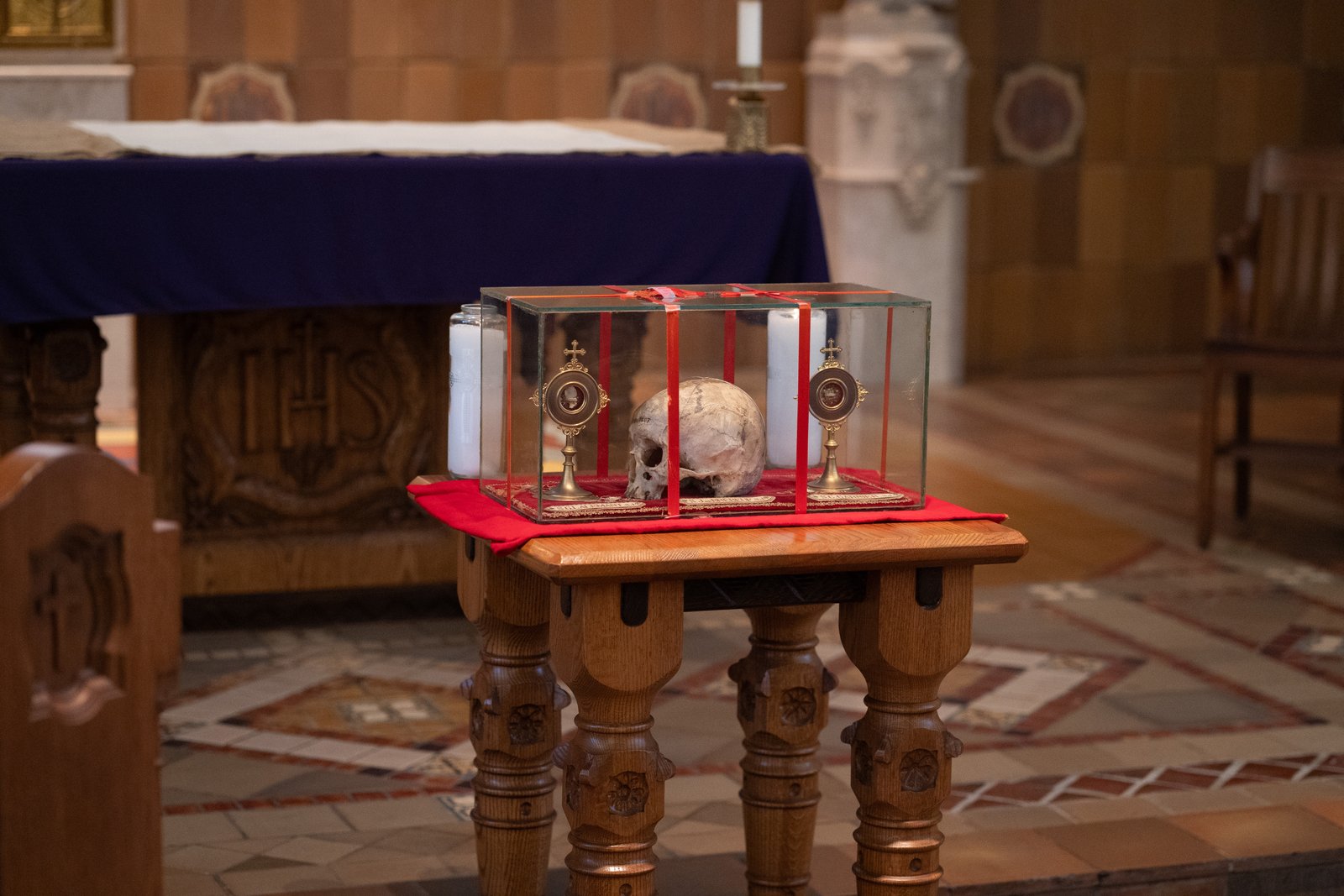
Examining the lives and legacies of St. Jean de Brebeuf and the other North American Martyrs allows people today to examine their own lives and where God is calling them to go, Fr. Immell said.
St. Jean de Brebeuf went to the ends of the Earth to follow the will of God. His martyrdom and his relics are meant to inspire people to ask where God is leading them today.
“I think there is sometimes a false safety we have in our Catholic identity, a safety that we have already given as much as we can give to the Lord,” Fr. Immell said. “But Brebeuf is a witness to this call of constant conversion. There is always something more we can give to Jesus to do His will. My hope: people will witness his courage, the martyrs’ courage, the martyrs’ faith, their willingness to give everything and give all that is possible to the Lord.”











